By Nancy Alexander, PT, CSCS
At lunch recently, a friend stopped and looked at me with a serious tone and said, “I have to ask you something.” Her facial expression immediately put an end to the light chatter we had been having. “How do you fall?” she asked. “I’ve had some falls in my past and I don’t want to do it again. I’m working on my balance but I wonder… is there one best way to fall?” What a great question.
We all worry about it, don’t we. But most of us don’t want to talk about it. What I appreciate most about her question is that she is seeking out a way to reduce her risk of injury. She is taking action and being proactive to better her mobility and her health. Her chances of improved safety just increased. Turns out there are preferred ways to fall. I recalled some resources that I had available to me and I told her I would research this more and respond with my findings. I’m sharing these with her and now with all of you.
Falls are serious business. Here is proof:
- Falls account for over 3 million ER visits per year
- Fractures are the most serious consequences of falls (5%)
- More than 95% of hip fractures are caused by falling, usually by falling sideways
- Falls are the most common cause of traumatic brain injuries (TBI)
- In the USA, one in three persons over the age of 65 will experience a fall; half will be repeat fallers
- According to the CDC (Centers for Disease Control) in 2014, more than 15,000 persons in the USA, over the age of 65, died as a result of a fall
- For persons 65-84, falls are the second leading cause of injury-related death
- For those 85+, falls are the leading cause of injury-related death
Fall prevention includes improving our physical health such as flexibility, strength, and balance. All are worthwhile, just not a topic for today. Our focus here is how you can decrease your chance of serious injury by the way in which you fall. This has been studied and ways have been identified to help define safe landing strategies. Some information comes from the martial arts community where participants are taught how to fall. Much of the information in this article is from a fall prevention certification course I completed in 2021. Sources are provided at the end of this article for your reference.
Here are six ways to improve fall safety:
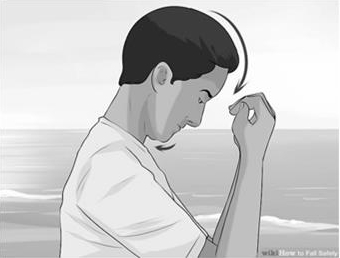
- Protect your head.
The most important body part that you need to protect in a fall is your head. Head injuries can be very serious, even deadly. Make sure you prioritize protecting your head as you fall by properly positioning it.
- Tuck your chin down, lowering your head.
- If falling down face first, turn your head to the side.
- Bring your arms up to head level for additional protection. Put them in front of your head if falling forwards or behind your head if falling backwards.
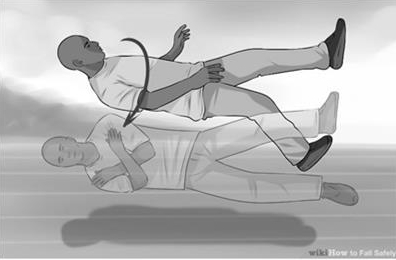
2. Turn as you fall.
If you are falling either straight forward or straight backwards, try to turn your body so you land on your side. (I would also add to use your arms to protect your head, versus crossing your arms like the picture shows.) Falling directly on your back can cause serious injury to it. A frontal fall can cause damage to the head, face, and arms. By landing on your side, you can reduce the chance of injury by landing on more soft tissue and dispersing the impact. (See #5, Rolling).
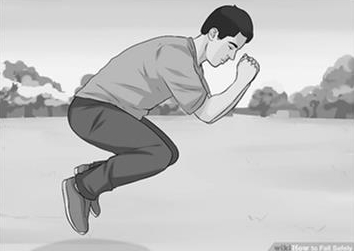
3. Keep arms and legs bent.
It may be tempting to try and catch yourself fully as you fall with your arms. However, landing with your arms straight out and absorbing the full force of the fall with them can cause injury. Try to curl up keeping both arms and legs slightly bent as you fall. If feet are still on the ground, try to squat down. Landing fully on your arms straight out can break both your wrists and arms.
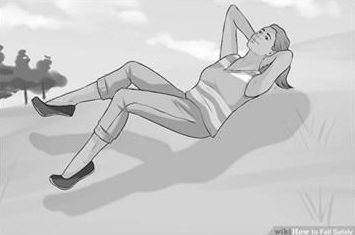
4. Stay loose.
This is perhaps the hardest thing to do. Tensing up during a fall can increase the chances of sustaining an injury. The tension in your body won’t allow for the absorption of force from the fall. Instead of spreading the impact out over a flexible body, the parts that were kept taught are more likely to break instead of going with the motion. You can try breathing out as you fall to help keep your body relaxed.
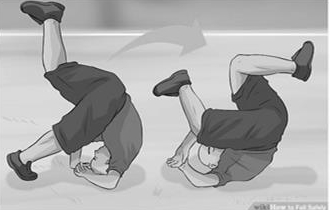
5. Roll out of the impact.
If you are able, a good technique to dissipate the force of a fall is to roll into it. By rolling, you send the energy of the fall into the roll, rather than having your body absorb the impact. Rolling to one side (versus a somersault as shown here) can help distribute the impact where there is more soft tissue.
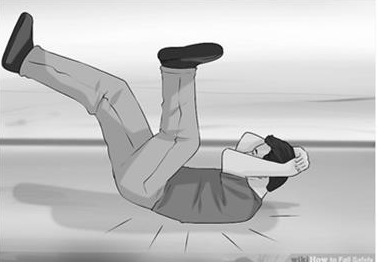
6. Spread out the force of the fall.
A big part of falling safely is to spread out the force of the impact over a large area of your body. Falling on a single point will result in that area taking most of the damage. By spreading out the impact, you reduce the chance of serious injury to a single part of the body. If falling backward, try to squat first and bring arms to the back of your head.
If you fall, try to breathe, think. Ask yourself, “Am I okay?” Assess if you can move all your extremities including your head. Can you get up safely? If so, do it. If not, or if you feel you need medical attention right away, call for help. If you live alone and/or know your mobility is compromised, consider a personal alert of some kind. If you witness someone fall, ask them how they are? Are they answering appropriately? Ask them if anything hurts. If pain is reported, always err on the side of caution and call for help. You could inflict additional harm if you try to lift them up yourself.
Summary
Depending on your physical condition, you may be limited by what you are able to do in case of a fall. The recommendations above do not take everyone’s abilities into account. Simply put, some or all of these techniques might not be appropriate for you. For more information, please consult your own physician or movement specialist for recommendations more suitable for you.
Of all the 6 ways to improve the safety of your falls, protecting your head is likely the most important. Tuck your chin and raise your arms to protect your head. Rolling is also worthy of consideration. Have you fallen recently? Is there one direction that you fall most of the time? If so, focus on that technique. Practice it if you feel confident in doing so. Be sure to have the right professional supervision and the right protective equipment around you for your safety. Your local physical therapy clinic may be able to provide that for you.
A question you may have is, “Can you really remember these techniques if you fall?” Falls happen quick. I don’t know the answer to that. But what if you just called on one technique and it saves your head, for example, from direct impact with a hard surface. That’s a chance I am willing to take. This knowledge can’t hurt you, can help, and it might even decrease your fear of falling. Be well friends.
Sources:
Shelly Denes, PT, C/NDT, Instructor for 2-Day Fall Prevention Specialist Certificate Course, PESI, Inc., 2021.
Moon Y, Sosnoff J, Safe Landing Strategies During a Fall: Systematic Review and Meta-Analysis, Archives of Physical Medicine and Rehab, Vol 98, Issue 4: 783-794, April 2017

These are great cautionary seeds for the “Fall!” Thank you.
You’re welcome Linda. Stay well!